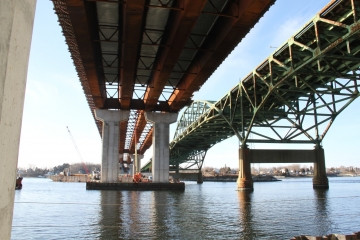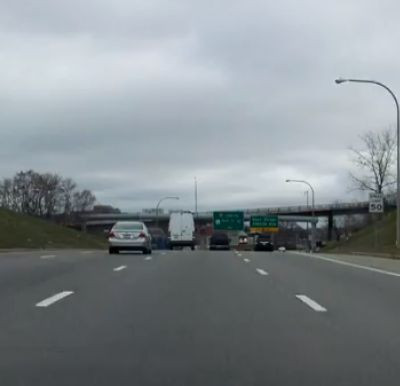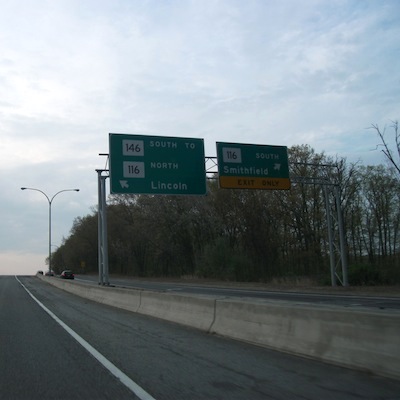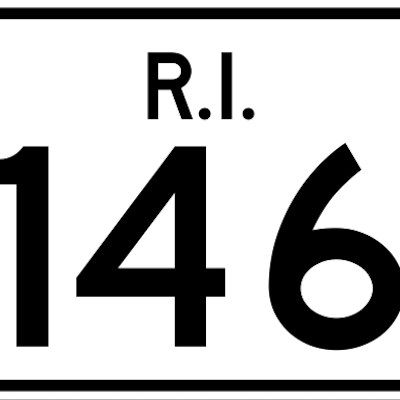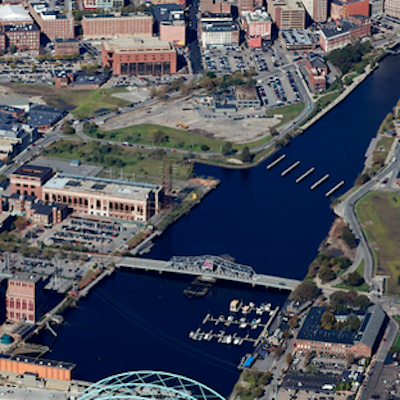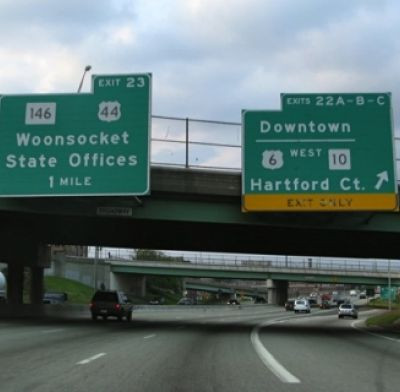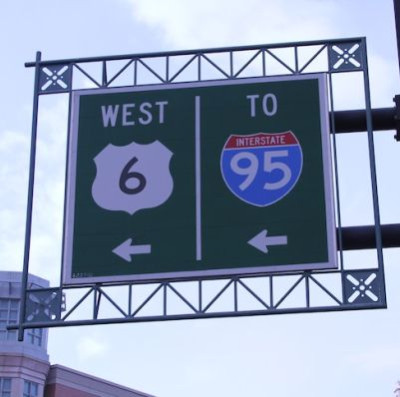Bishop: Bridges, Tolls and a Tale of Three States
Thursday, July 23, 2015
Not since Robin Hood and Little John fought over a footbridge in Sherwood Forest has so much ink been spilt over bridges as Rhode Island has seen in recent weeks.
It is a perennial saw that Rhode Island’s bridges are bad and getting worse. But the stimulus friendly DOT under our new governor has caused the present consternation by proposing not to buckle down and prioritize its spending to climb out of this hole. Rather DOT wants to borrow $700 million just as the state’s road debt is finally improving. For a decade RIDOT has been struggling to adopt a pay-as-you-go approach to road work, thus putting the moneys previously consigned to interest and bonding expenses to work on the roads.
Whether this is paid for by tolls on trucks is a side show compared to the lunacy of undertaking such an effort without contemplating how it is that Rhode Island is in the top five states for spending per mile on its roads but has the highest percent of deficient bridges in the country?! Giving $700 million dollars to the combine of bureaucrats, contractors and labor that have produced that record is indefensible.
GET THE LATEST BREAKING NEWS HERE -- SIGN UP FOR GOLOCAL FREE DAILY EBLASTWe had a billion dollars of federal stimulus that we could have chosen to focus on this problem. But that apparently didn’t constitute enough ‘shovel ready’ spilling of money quickly enough to suit our politicians. If our bridges are unforgivable than spending stimulus money for new sidewalks was equally so.
What to do now?
There are administrative challenges, but it is hard to know whether 3 senior engineers at RIDOT were sidelined for being part of the problem or part of the solution.
What seems clear is that the Governor has chosen leadership at the department with an eye toward spending money over getting results. Otherwise the first step would have been serious inquiry into the disconnect between spending and results at RIDOT.
And this spendthrift culture appears reinforced not only by her choice in appointing an executive from the Laborers Union to head RIDOT but in choosing as his deputy a veteran of New Jersey transportation administration, Peter Garino.
While the Providence Business News opined that Mr. Garino had a resume more suited to the directorship, we would quibble with that assessment. New Jersey is the one state in the country that spends drastically more per mile than Rhode Island. And unlike Rhode Island, New Jersey has taken on a disastrously high level of debt for its highway system. And it doesn’t even come out better than average on the condition of its bridges!
Mr. Garino worked on the mass transit side at the time he was tapped to come to Rhode Island and this state-to-state comparison isn’t meant to saddle him with the blame for New Jersey’s inefficiencies. But if we were to look for transportation leadership, New Jersey is not the place we should start.
The Typical Excuses
The typical excuses will be trotted out about how you can’t look at the numbers in the Carolinas or get somebody from Georgia as a comparator for Rhode Island. “They don’t get frost like we do. They don’t have the age of infrastructure. Rhode Island isn’t that much worse than Massachusetts or Connecticut so why is everybody making a stink."
Suggesting we can only compare ourselves to other big spending northeast liberal states gives the predictable outcome. But, it isn’t only Rhode Island that should be looking itself in the mirror, it is New Jersey, New York and all of southern New England. All those states fall amongst the highest spending with the worst bridges to show for it.
But more importantly, for Rhode Island, our economy lags all those states. We have to excel at something. If other states want to be inefficient in their road spending and put it down to frost and aging infrastructure, we don’t have to do the same.
Ohio far better to emulate than New Jersey
The better comparator to challenge Rhode Island, and a place we ought to look for inspiration, if not to pirate transportation administrators, is a state like Ohio. Last we looked they had frost in Ohio and aging infrastructure. And its state owned road system is very similar in character to Rhode Island with an average 2.5 lanes per mile. Bridge count per mile is very similar to Rhode Island’s. You might guess that Rural/urban road mix gives Ohio an advantage but you would be wrong? Actually there is a lesser percentage of rural state owned roads in Ohio.
With similar challenges, Ohio finishes above average in virtually every category of road condition while spending one third per mile what Rhode Island does.
Yes their road system is 20 times the size of Rhode Island’s, but contracts are made in discrete increments and maintenance is a per mile exercise. There may be better in-house management and control in Ohio. They might gain some modest purchase efficiencies for equipment and supplies based on scale but did you notice we said they spend one third of what Rhode Island does per mile and get far better results. We don’t need to borrow money, we need to borrow ideas for fostering the institutional culture that can give those kind of results.
One hopes, although it is not at all apparent, that this would be the transportation transformation Governor Raimondo has in mind. She just miscued on her first effort.
Transportation as economic development
There has been a theme of her administration that was echoed by Peter Alviti when he was tapped for RIDOT director, that the department’s work should focus on improving the economic development climate. Well, we may be the laughing stock for having spent billions on infrastructure with lousy bridges to show for it. We do have to come terms with that. But it is certainly not our percentage of deficient bridges that holds back economic development, especially of the knowledge based economy.
Teespring, a Brown University spinoff that Go Local reported is leaving Rhode Island this week is more dependent on information highways. Of course they wouldn’t want their employees falling off bridges on the way home from work but there is no indication that what will be a long term fix for a long term problem with bridges is a key to economic development of this sort.
In spite of the convenience of the internet, face time and personal interaction are still principal characteristics of the university and business environments that can give rise to economic opportunities such as Teespring. Meanwhile we continue to promote our state, with some justification, as the place to escape from business. If there is a transportation project that suits both these efforts while representing a major infrastructure investment that might be suited to tolling it is the completion of the highway connecting the Newport Bridges and URI to Route 95.
It is a travesty that we have allowed the anti-car, anti-suburban mentality, thrust upon us by progressive elites, to orphan our state university and limit access to some prime tourist destinations. This project has been on RIDOT’s shelf for so long they have forgotten about it, Here is a road that might be assessed for whether the level of use in concert with tolling could allow this long delayed infrastructure to be attained.
Where were advocates for bridges before?
For bridges, we must prioritize existing moneys, facing down the boondoggles in transportation like our $25 million dollar bike path park on the old Washington Bridge and a $40 million dollar monument, or perhaps mausoleum, to commuter rail in Wickford (because the folks in Wickford didn’t want a parking lot on their side of the tracks?!). Where were the very interests decrying the catastrophe of deteriorated bridges when these spending decisions were made? Nobody, including those union jobbers who did the work, bothered to make a stink about dangerous bridges while that cash was being burned on the alter of ‘intermodality’.
We can’t have that money back, it can only serve as a lesson that the folks running our department of transportation are not that interested in the safety or convenience of those who pay the gas tax. Maybe we could start by drumming out the bureaucrats who made those decisions rather than have a spat with road engineers who aren’t spending money fast enough or rub a few folks the wrong way, or whatever secret offense against the new Rhode Island order they have committed.
Poor spending priorities coupled with what is no doubt a cozy contracting environment that inefficiently uses what moneys we do spend on the roads is why we are in this predicament. Just throwing more money at the problem will simply get us more debt without improving much.
Whatever the source, we should stick to a pay as you go plan. These bridge projects take years to design and execute so we should identify the resources we will devote to bridge repair and stream the projects so that the moneys identified will be available as the project payments are due. This stretches out over years. There is no need to rev up the engines of those who brought us 38 studios to issue yet more moral obligation bonds on our behalf.
Of course, this is Rhode Island, where we seem to think if things aren’t going well, we should spend twice as much going in the same direction.
Brian Bishop is on the board of OSTPA and has spent 20 years of activism protecting property rights, fighting overregulation and perverse incentives in tax policy.
Related Slideshow: RI’s Most Dangerous Bridges
The American Road and Transportation Builders Association recently released a list of the most traveled, deficient bridges in each state. In Rhode Island, those bridges were:
Related Articles
- Brian Bishop: Rhode Island Energy Policy: The Gift That Keeps on Taking
- Bishop: Transformation – So Far it’s All Talk in Providence
- Bishop: Taylor Swift Move Over
- Bishop: Keeping the Pawtucket Red Sox Without Seeing More Red in Providence
- Brian Bishop: A Turning Point in RI: Will Voters Approve a Constitutional Convention?
- Bishop: What Do The State House & Downton Abbey have in Common? An abiding sympathy for King Canute
- Bishop: With ‘help’ like this…? - State Policy For Providence A One-Way Street
- Pam Gencarella: Witness the Crowding Out of Public Services
- Pam Gencarella: RI Has Lost Cabin Pressure
- Pam Gencarella: Why You Should Care About a Constitutional Convention
- Pam Gencarella: It’s Easy to Vote for Santa
- Pam Gencarella: Don’t Touch That Dial
- Pam Gencarella: A Race to the Top or Running in Circles?
- Pam Gencarella: A Civics Lesson From the East Bay
- Pam Gencarella: Another Bubble to Burst in RI?
- Pam Gencarella: Will Spring Bring Renewed Hope to RI?
- Pam Gencarella: Something’s Rotten in the State of Denmark, er, RI
- Pam Gencarella: Introducing The People’s Resolution
- Pam Gencarella: Is the Pendulum Swinging Back Toward the Center?
- Pam Gencarella: Context Is What’s Needed - Part I
- Gencarella: Public Union Benefits Limit What Our Government Can Do For Taxpayers.
- Gencarella: Can We “Make it in RI?”
- Gencarella: A Drop In The Proverbial Ocean State Budget
- Gencarella: Let’s Leave It A Local Issue
- Gencarella: RI Firefighters: Public Servants, Hardly Indentured Servants
- Pam Gencarella: Where Does Raimondo’s Vision Put Us in Five Years?
- Gencarella: Are Local Governments Kidding Themselves?
- Gencarella: RI Stands Apart From a World Where Change Is the Only Constant
- Pam Gencarella: Surprised, Bewildered, Shocked, Disappointed
- Pam Gencarella: What’s All the Fuss About RhodeMap RI? If You Like Your Municipality, Keep It
- Gencarella: What Side Are You On? Do Organizations & Consortium Members Really Support RhodeMap RI?
- Pam Gencarella: The Twilight Zone


